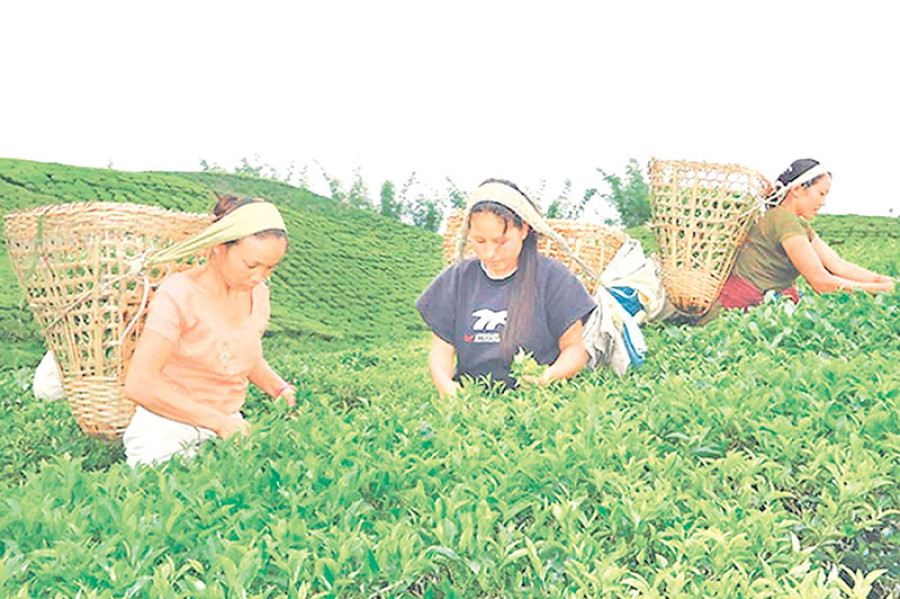Opinion
Tea for global market
As Nepal has increasingly been exporting tea, it must strive to develop it as a brand
Nanu Jha
Tea is deemed as one of the most popular beverages in the world. Globally its production is steadily increasing doubling in the past 20 years from 2525 million metric tons in 1995 to 5305 million metric tons in 2015. However, the gap between production and consumption is widening. In 2015 consumption was 4999 million metric tons resulting 307 million metric tons surplus. In 2010 surplus was 127 million metric tons. The tea leaves are processed to produce two types.
The tea leaves that are completely processed (withered fermented and fired) forms black tea entering in bulk in global market. The other type of tea is green tea produced when withered tea leaves undergo steaming or scalding to prevent fermentation and is more popular in China and Japan. In 2006, about 43 percent of the world tea produced was exported. In 2015, only 34 percent of the produced was exported and about 66 percent tea produced is retained in concerning countries for their consumption. Kenya is the global leader with 25 percent share in export, mainly black tea.
In Nepal, tea cultivation began with the establishment of the Ilam Tea Estate in 1863. Budhhakaran Tea Estate is the first private tea estate established in 1959 in Terai. The commercial cultivation of tea has been increasing since the establishment of Nepal Tea Development Corporation (NTDC) in 1966. In 1982, the government realising that tea is one of the most important cash crops and exportable commodities, it declared five districts, Jhapa, Ilam, Panchthar, Tehrathum and Dhankuta as “Tea Zone”.
In 1993, the government established National Tea and Coffee Development Board (NTCDB) with objective to organise tea and coffee farming, produce high quality products, and facilitate policy development towards market management export and import substitution.
Nepali tea is classified into two main categories Orthodox/green tea and Cut, Tear and Curl (CTC)/black tea. The growth and development in tea sector has increased tremendously after the active participation of private sector and small holding farmers in tea farming. Out of 40 plants, 25 for CTC and 15 for orthodox tea processing plants are in operation. Orthodox tea is produced in the hills from Chinese clones whereas Cut Tear and Curl (CTC) tea in the plains.
Nepal is almost self-sufficient in CTC Tea and about 95 percent of the Orthodox tea was exported as Nepal organic tea mainly in Europe, America and Japan. Organic tea fetches better price in the world market.
The present status of Nepalese tea in total export of the country is 3.42 percent. The private sector has been doing well in promoting Nepal tea in international market. In fact, India is the one of the major destinations for tea export but the exact data was not available.
Before 2001-02, Nepal was importing tea more than it was exporting. In 2003-04, reversing the trend,
Nepal exported 884 metric tons amounting Rs105 million and imported Rs1 million. In 2015-16, exported 13289 metric tons amounting Rs2400 million and imported amounting Rs68 million. This shows that export quantity and price have been increasing over the years.
Despite high global demand of organic orthodox tea its production and productivity is very low due to inadequate use of organic and bio-fertilizers, quality improvement in planting materials, proper analysis of soil, and energy conservation for improvement in processing.
In this regard research and development programs must be developed in collaboration with public and private participation. Scientific plantation methods should be introduced and focus has to be made on the organic tea cultivation because the international standards restrict the poor quality.
Globally, Nepali tea is favourable for the export, and thereby we can earn the foreign currency. It also has the potential to benefit large segment of rural population especially, female workers engaged in picking leaves. The Nepali exporters have to develop brand loyalties in their overseas markets and strive up to make packaging of their products conform to world market standards and specifications. There must be strong commitment and dedication from the government for quality tea production and export promotion.
Jha is an Adjunct Professor, at Himalayan College of Agricultural Sciences and Technology




 13.12°C Kathmandu
13.12°C Kathmandu











